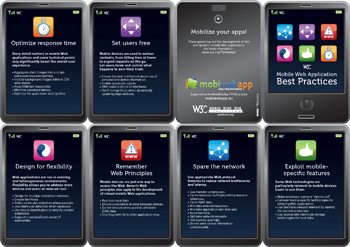W3C Releases Mobile Web App Best Practices

The World Wide Web Consortium (W3C), the standards body that has brought us such fun specs as HTML, XHTML (or what’s left of it), CSS and other exciting yet dry specs, has today announced that it has created a standard for mobile web applications best practices. From the Mobile Web Application Best Practices announcement:
W3C today issues standard best practices to create smarter mobile Web applications. The Mobile Web Application Best Practices offers practical advice from many mobile Web stakeholders for the easy development and the deployment of mobile Web applications that work across many platforms. The guidelines also indicate how to design Web applications that are efficient, well-suited to different contexts, and which boost the overall mobile user experience.
You can get to the full release here: W3C Issues Best Practices to Create Smarter Mobile Web Applications. The document has support from some players in the mobile industry: AT&T, The Boeing Company, China Unicom, China Electronics Standardization Institute, Deutsche Telekom, Electronics and Telecommunications Research Institute (ETRI), Fundación ONCE, France Telecom, Google, HP, MobileAware, Mobile Web 2.0 Forum, Nokia, Novarra, Openwave Systems, Opera Software, Rochester Institute of Technology, SK Telecom, Telefónica de España, University of Manchester, Vishwak Solutions, Vodafone, Volantis, and what the W3C calls “invited experts.” Given a key statement from W3C (emphasized by me in bold in the quote below), it makes sense that these organizations are interested in keeping their costs down by pushing developers to minimize network abuse.
Mobile Web Application Best Practices offers guidance on which Web technologies are particularly relevant on mobile devices. The guidelines also indicate how to design Web applications that are responsive to their usage context, while sparing the network and optimizing response time to significantly boost the overall mobile user experience.
In conjunction with this announcement, the W3C has also released its Mobile Web Application Best Practices (MWABP) Cards. The 32 best practices defined in the specification are divided into 6 categories, or cards, covering the categories “Spare the network,” “Set users free,” “Remember Web principles,” “Design for flexibility,” “Exploit mobile-specific features,” and “Optimize response time.” Given the recent slew of “card sets” as quick reference guides for everything from usability to accessibility, this approach isn’t too much of a surprise.
What is a surprise is that the cards are just a web page that happens to display well on mobile, but that’s about it (there is a PDF version, too). Given that just a few months ago the W3C updated its Cheat Sheet (W3C Cheat Sheet Now Includes HTML5), an app for mobile devices that also includes a section on mobile web best practices, it would have been nice to see this rolled up into that tool well. In a quick check at the Android Marketplace, I do not see an update available for the Cheat Sheet.
If you were paying attention in October, you might have seen when the MWABP Cards were released for review, or when the MWABP became a proposed recommendation. That they have wrapped this process up relatively quickly to come up with a final release is nice to see, considering the comment period ended just under a month ago.
Because I am always interested in recommendations for technical implementation, I pulled this one item out of the list:
- Make telephone numbers “click-to-call.”
There is no direct link to th relevant part in the MWABP document, but you can find it in section 3.5.6 Make Telephone Numbers “Click-to-Call.” The document says to use the tel: URI scheme (protocol if that’s how you know it, even though that’s incorrect) in an href along with the full international phone number, as outlined in RFC3966. The document then goes on to say:
Note that at the time of writing support for this RFC is limited and device compatibility should be verified before deployment.
Sadly, the document gives no indication what to do to support desktop browsers that cannot process that link. The lesson here is that sometimes best practices in a vacuum can butt up against other best practices (like making sure all your links work for all users).
Regardless, there are some good standards in here, and with a little technical and implementation know-how, developers should be able to put it to good use.
Leave a Comment or Response